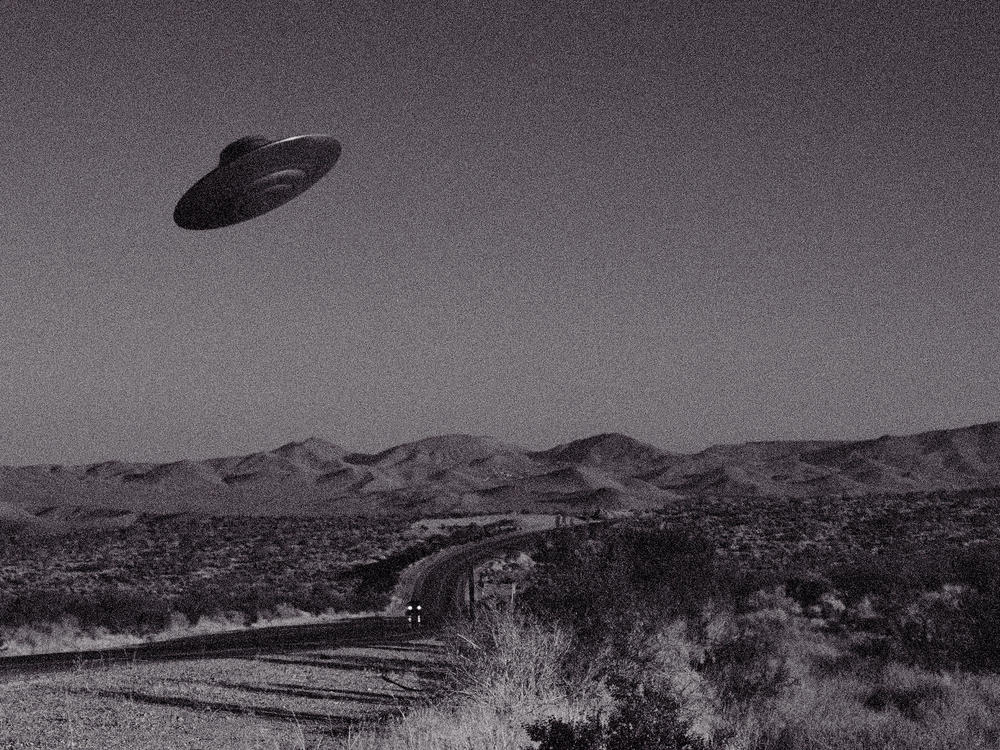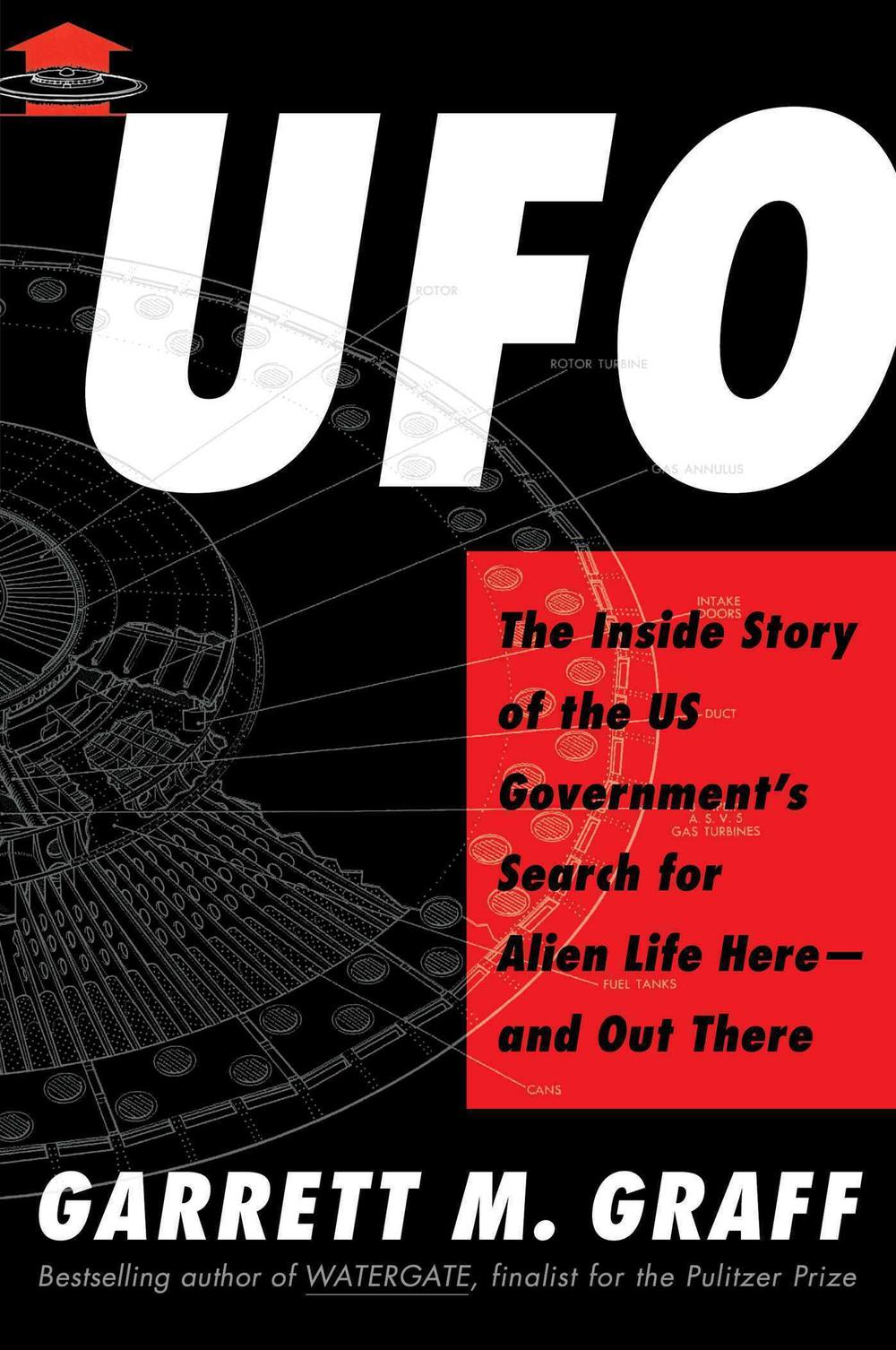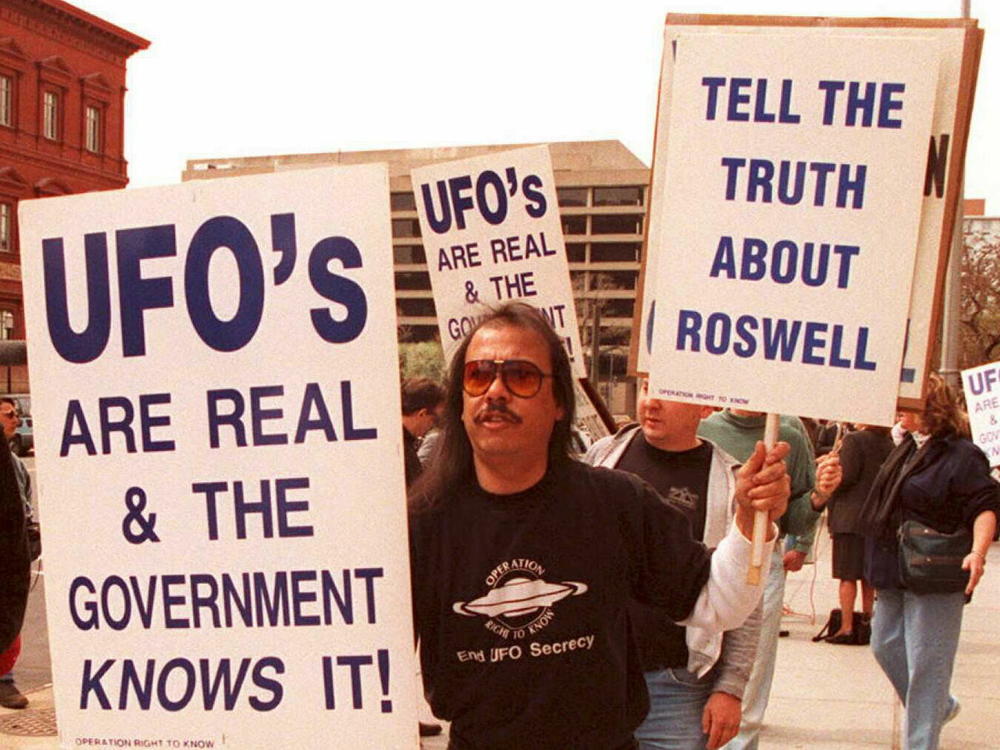Section Branding
Header Content
How the Roswell 'UFO' spurred our modern age of conspiracy theories
Primary Content
Humans have been spotting — and remarking on — mysterious forms in the sky since the beginning of recorded history, but author Garrett Graff traces the "modern age of UFOs" to a flurry of sightings that occurred around the U.S. following World War II — and to a particular incident that happened in Roswell, N.M.
In July 1947, Roswell rancher Mac Brazel found some strange materials on his property. He took the debris to a nearby military airbase, where the commander made a surprising declaration: Brazel's finding was evidence of a flying saucer.
"The local paper picks it up," Graff says. "It very quickly becomes a national story."
Though the Air Force retracted its initial judgement — upon closer examination, it seemed that the debris was actually the remains of a military weather balloon — the seeds of an enduring conspiracy had been sown. Decades later, Graff says, in the 1970s, as the country was reeling from Watergate and the war in Vietnam, a story emerged that the government was covering up evidence of alien spacecraft and even alien bodies.
"The Roswell story is just an incredible one because of how it represents that feedback loop, and the world of conspiracies that grows up around it," Graff says. "These conspiracy theories grow ever larger and darker, and include the idea that the government has made peace treaties with alien civilizations, that the government has given permission for alien civilizations to kidnap and abduct humans."
Graff writes about Roswell and the possibility of extraterrestrial intelligence in his new book, UFO: The Inside Story of the US Government's Search for Alien Life Here — and Out There. He also draws a direct connection between the Roswell conspiracy theories and the rise of the so-called "deep state" in American politics.
"The foundation of our modern conspiratorial age in our politics begins in the wake of Watergate with UFOs," Graff says. "You don't get January 6th and the big lie in the 2020 election without the foundation of those UFO conspiracies in the '80s and '90s."
Interview highlights
On the government's belated attempt to clarify the Roswell incident
The Clinton administration puts out two big reports as the 50th anniversary of that Roswell crash rolls around that tries to explain for anyone who will believe it, that there was a cover up at Roswell, just not about aliens, that, in fact, the balloon that was recovered was a secret development project known as Project Mogul that was trying to develop a giant balloon that could detect Soviet atomic tests. It would have looked like a UFO to the Air Force personnel looking at it. It was a giant series of balloons. It was like 30 balloons. It was 100 feet taller than the Washington Monument, packed with sensors. It did not look like a regular weather balloon at all. And so it was in some ways a literal UFO.
And then the confusion around reports of bodies being recovered actually had to do with a series of other secret government tests at the time where the U.S. in the White Sands Proving Grounds around Roswell was testing ejection seats and parachute dummies. And so there were bodies falling from the sky that the military was then going out into the desert and collecting and trucking away. It's just that they were parachute dummies, not alien bodies.
On why aliens probably wouldn't care about Earth anyway
One of the biggest revolutions I think that we have had in human knowledge and understanding in the last 25 years is just how likely it actually is that there is life and intelligent life out there across the universe and probably actually quite a bit of it. The math to me is very much on the side of aliens existing. The challenge is the chances that they are anywhere near enough that we would ever notice them or that they would notice us, I think is vanishingly slim. ...
You end up with this very human-centric view that any alien civilization would actually care about us in the first place. The most likely answer is that nobody knows that we are here and that nobody would care — that we are a pretty young and immature civilization on a pretty ordinary planet, in a pretty ordinary solar system. The idea that aliens would bother flying across the vastness of space in their flying saucers to come and befriend us or invade us or harvest our organs for energy and food, I think, ends up being basically a creation of pop culture and Hollywood.
On how discovery of intelligent life likely won't be cinematic – it'll be about trash
To me, the idea that intelligent life is out there is, I think, almost a foregone conclusion at this point. It's moved scientifically in the last couple of decades, I think not just from a possibility, but to a probability. And then I think the other thing that I came away from this book really fascinated by is the way that we misunderstand how we will probably someday discover intelligent life elsewhere in the universe. ... We have these two first "contact" scenarios. ... You have the Jodie Foster Contact idea of a very clear radio message from outer space, or you have the Independence Day, "Take me to your leader," alien spacecraft appearing over the White House kind of scenario. ...
And what we are probably going to see instead is something that's much more ambiguous and puzzling because no one knows we're here and probably no one cares. And so what we're probably going to first discover is a piece of space trash. What the Harvard astronomy chair, Avi Loeb, equates to the idea of, like, an empty plastic bag blowing through our cosmic backyard. ... And that it's going to be ... a literal piece of space junk from some intelligent civilization out there that we're going to see and we're not going to have any idea who it's from, how long it's been out there, or whether that civilization still exists. Because part of this is there could have been a lot of intelligent civilizations that have come and gone and we might be alone right now.
On the flying saucer image feedback loop
Ironically, it is the government and the Air Force that first popularized the term "UFOs" in the late '40s and early '50s to try to destigmatize the conversation around flying saucer sightings, because very quickly people begin to laugh and make fun of people reporting flying saucers. And then this becomes a huge part of pop culture. In the early 1950s, you have the first wave of alien invasion movies and it becomes this very obvious feedback loop that plays out across decades of the pop culture interest in flying saucers and UFOs and aliens driving sightings which drive national security concerns, which then drives and inspires more pop culture that then inspires more sightings. And this is a self-perpetuating phenomenon and puzzling mystery that continues for the next 80 years.
On why UFO reports are considered "classified" in government records
A lot of it just has to do with how broken the classification system actually is, that the government routinely classifies all manner of knowledge and reports and sightings about stuff that's important and not important. I've spent 20 years covering national security, writing about all types of different topics, from nuclear strategy to the war on terror — and the length of time that some of these documents remain classified is really laughable.
On the difference between mysteries and secrets
You have to draw these distinctions between what are secrets and what are mysteries. And a secret is: What is the capability of the latest Chinese hypersonic rocket? That is a knowable fact that we just don't know. And then you have mysteries: Why does Stonehenge exist? You know, things that. We probably will just never be able to solve it, or at least not solve with the knowledge that we currently have. And the line and the challenge of UFOs and UAPs [Unidentified Aerial Phenomena] is across 80 years is we've never really understood what percentage of that is secrets and what percentage of it is mysteries. And I think my understanding is that probably a bigger chunk of it is mysteries. It's phenomena that we don't understand [more] than it is secrets, the government covering up alien spacecraft that it has that it's not telling us about.
Sam Briger and Thea Chaloner produced and edited this interview for broadcast. Bridget Bentz, Molly Seavy-Nesper and Beth Novey adapted it for the web.
Copyright 2023 Fresh Air. To see more, visit Fresh Air.




